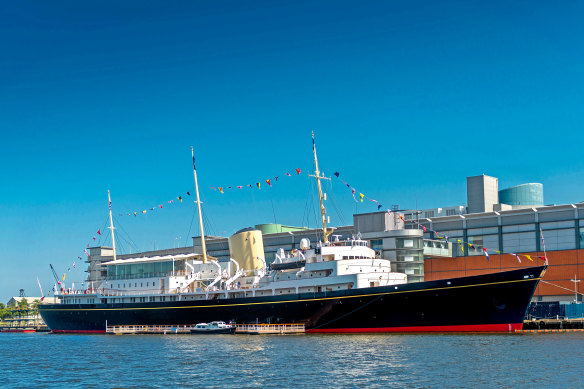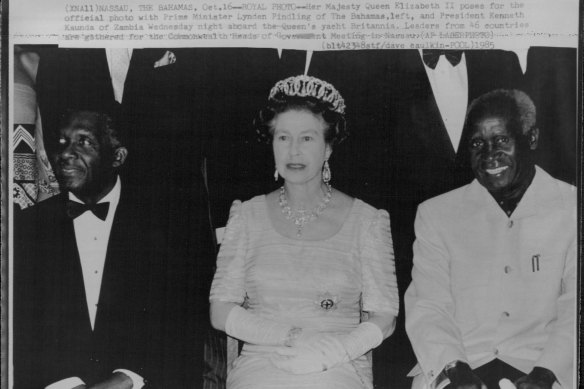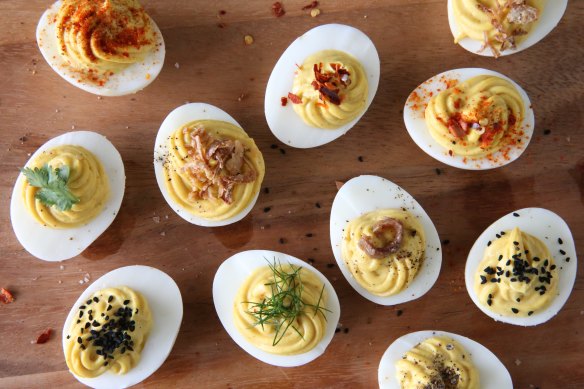Elizabeth II’s impact on the world in the last, difficult half of the 20th and early 21st centuries was nothing short of monumental. She did of course inject new life, energy and meaning into the Commonwealth – a project of former subject nations that was dying a slow death as colonial Britain dissolved in the 1960s and 70s. It was her life’s work. But it was the small, personal interactions with her subjects that often resonated longer and with greater impact than her global outreach.
Forty years ago (almost to the day) a young Queensland journalist found himself being served dainty canapes and finger sandwiches at a reception on the Queen’s floating palace, the Royal Yacht Britannia. It was late September 1982 and the Queen and Prince Phillip were in Brisbane to open the Commonwealth Games. Forty-six nations, 1600 athletes and a 13-metre mechanical winking kangaroo, Matilda, made headlines around the world. And so, as one does, Her Majesty invited 250 of the great and good to drinks on her vessel. To this day, it is unclear why I was invited.
The Royal Yacht Britannia.
Not even my editor was sent the thick, gilt-edged invitation in the mail. It’s not every day one gets a card which begins “The Master of the Royal Household requests the pleasure of the company of Mr Robert Broadfield…”
So convinced was I that it was a mistake, I rang Government House to check. I was assured that yes, my name was definitely on the list and “would I be joining Her Majesty?”
Um, yes. Thank you.
I arrived early, a nervous ball of country boy with a sparkling new $50 suit, polished shoes, a precision haircut and my mother’s advice on my mind: “Don’t be dull. Ask lots of questions about other’s lives. Encourage conversation. If you don’t like something, wrap it in a napkin and stick it in your pocket. Don’t drink too much. And remember, you’re not as fascinating as you think you are.” She had a knack for sage advice wrapped in a put-down.
I sucked down a couple of darts at the gates to Newstead wharf, to kill time and wait for the crowd to swell. Eventually, I walked up to the boat.
A nattily turned-out junior officer met groups at the bottom of the gangway and guided us aboard. The Britannia was draped in lights strung from stem to stern and over her masts. Strings of party lights were laced around the impeccably white canvas tent over the ship’s fantail. Her navy-blue hull was polished like a mirror. There was a ship’s bell mounted on a polished wooden stand at the foot of the gangway. It looked as if it had been burnished a hundred times with a toothbrush and Q-tips. It was a warm evening. The river smelled, well, tropical.
We were directed astern to the teak-floored fantail. And there she was. Topped with a small tiara, dressed in a waisted cocktail frock and sensible shoes, QEII was chatting amiably with a massive black games official sporting national dress – floor-length robes of every colour imaginable – and a white-toothed smile as broad as Stonehenge. It was a diverse, colourful crowd.
As you do at these things, I gravitated toward a few friendly faces. Conversations started. Stewards delivered drinks – very mild gin and tonics and, if memory serves, beers – and the crowd swelled. The party moved to Britannia’s state dining room, cleared of tables and chairs.
The canapes arrived on silver trays lined with thick linen napkins. These were unlike anything I’d seen before. Pate piped on tiny, round, toasted croutons, topped with a cross of two chive stems; small rounds of thin, dark bread – I think it was pumpernickel – spread with soured cream and topped with Scottish smoked salmon; and exotic and miniscule cucumber sandwiches (the bread had been rolled thin with a rolling pin to give the sandwiches their desired regal dimensions).
Her Majesty with then-world leaders aboard Britannia in 1985, three years after the party I’m writing about.Credit:AP Laserphoto
We had been exposed to canapes before. I think my mother called them hors d’oeuvres which we wittily translated into horses doovers. My mother’s cookery came from the CWA cookbook and the Australian Women’s Weekly, home of the sainted Margaret Fulton. Mother banged out her hors d’oeuvres, finger sandwiches and cakes at the drop of a hat, for everything from tennis morning teas to afternoon teas for her girlfriends and the tea tent at our tiny primary school’s annual fete.
Her canapes were, ahem, more rustic than the Queen’s. She always nailed the delicate, crust-off finger sandwich, but the smoked oysters on Jatz, a huge hit in its day, would never have made it onto the royal silverware. Similarly, her devils on horseback and her large slices of lemon cake and seed cake, simply trimmed-down serves from the shearer’s smoko, would not have pleased the royal household. But they were bloody brilliant. To see a bunch of women – all wearing Nana Mouskouri-style kaftans, slingbacks and hair so bouffant it took half a can of VO-5 to get it vertical – carving their way through thick pikelets draped in trawler loads of smoked salmon or hugely deformed home-made puff pastry in vol-au-vent form was the height of sophistication.
Or so I thought. Until that night.
I have never forgotten those canapes. To this day, I make variations of them as antipasti or drinks party food. Funny isn’t it, that with all the things I could have taken from that remarkable, fun drinks party on the Britannia, it was the canapes which afforded me the greatest memories: a window into an unknown, elegant world of food and booze service.
After two hours of chat and laughter, canapes and weak G&T, a hand pressed discreetly into the small of my back with an “If you don’t mind, Sir” and I and others were ushered gently in the direction of the ship’s rail. I looked for somewhere to leave my drink. The young officer said, “No, Sir, keep it with you.”
Then, as we gathered along the port rail of the ship, away in the darkness at the end of the jetty, a military band started playing show tunes. They never tell you about this part. The royals, apparently, love the surprise and delight on people’s faces. The band, in all its full parade kit marched into the light cast by the ship’s spotlights, came to a halt and banged out a small bracket of cheerful tunes – a playlist designed to delight rather than impress. I wished it would never stop.
I never did get to meet the Queen. She was doing her job of getting around the party and meeting most of her guests. I always seemed to be in the wrong place at the wrong time. I had a chat to her husband, the accident-prone Prince Phillip, in a small group of athletes and coaches. Regrettably he was perfectly well-behaved.
Rob’s canape du jour
My favourite canape is devilled eggs. No one expects them on a platter these days – they’re so old school – and yet everyone is delighted with them. It proves my theory that the greatest flavour on a plate is nostalgia. Here’s my recipe, with a little help from Australia’s kitchen goddess, Margaret Fulton:
Devilled eggs, a 1970s staple, but still one of my favourite canapes. These ones by Jill Dupleix. Credit:Peter Rae
Ingredients:
- 12 eggs
- 200g (2/3 cup) mayonnaise
- 1 good tablespoon of Dijon mustard
- 3 tablespoons finely chopped chives
- Cayenne pepper to garnish (optional)
Method:
Boil eggs in large saucepan of water about 7-8 minutes or until hard. Cool, then peel and halve each egg. Carefully scoop egg yolks from whites into medium bowl. Place egg white halves on serving platter. Mash egg yolks with mayonnaise and mustard until smooth; stir in chives, season to taste.
Spoon mixture into a piping bag fitted with 1.5-centimetre fluted tube; pipe mixture into the egg halves. Sprinkled with extra chives, and if you like a bit more devil in your devilled eggs, a tiny sprinkle of cayenne pepper will pep things up. If you don’t own a piping bag, just drop heaped teaspoon-sized dollops into the whites and smooth them down.
Most Viewed in National
From our partners
Source: Read Full Article










